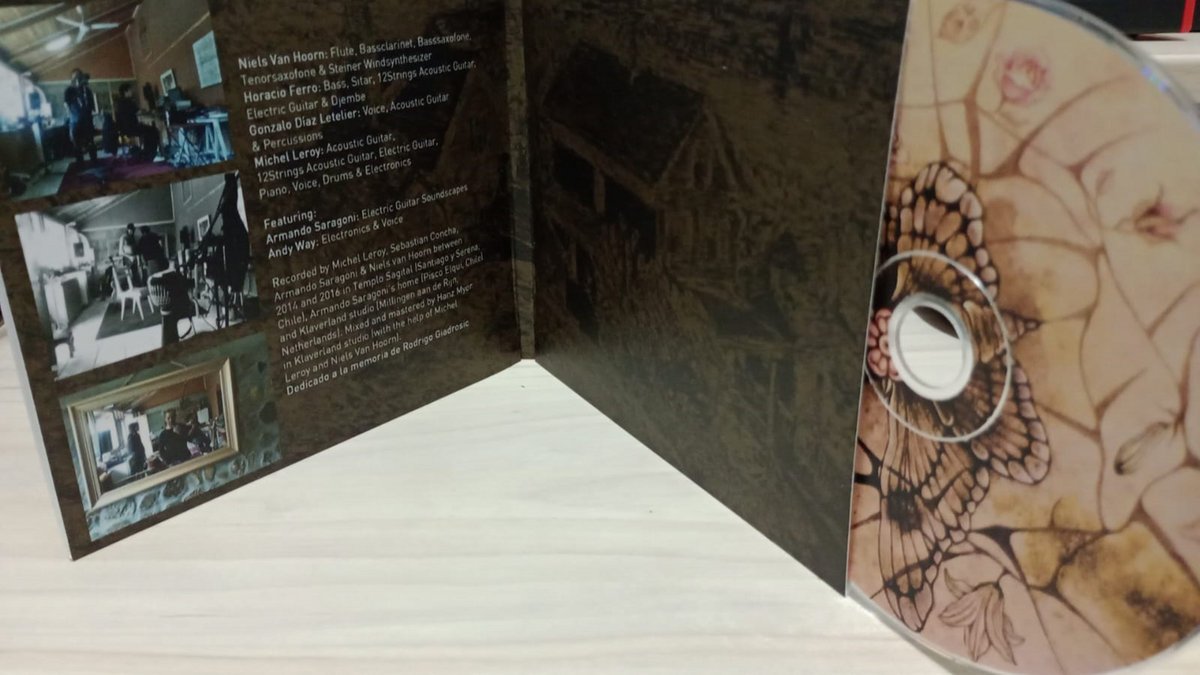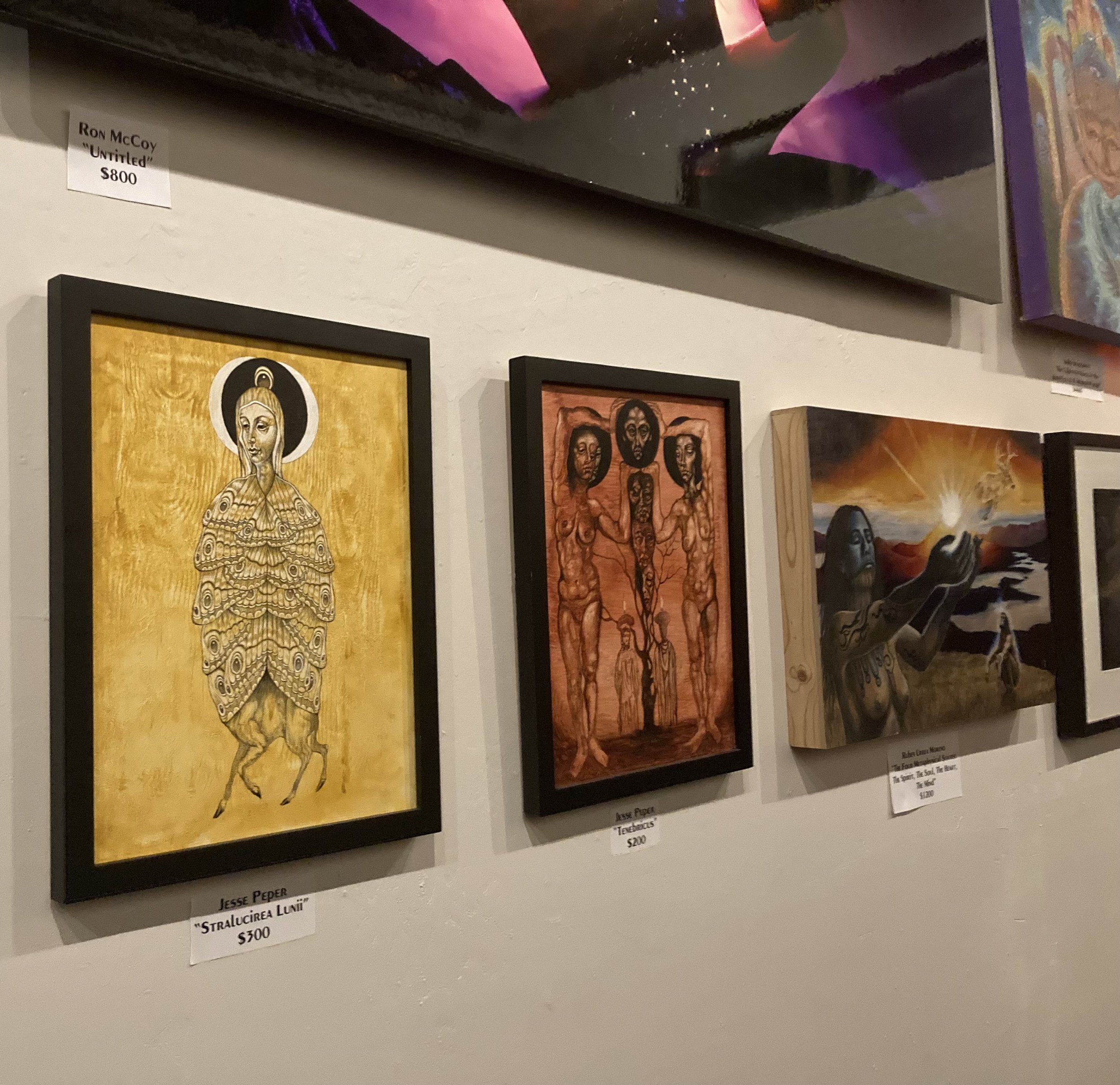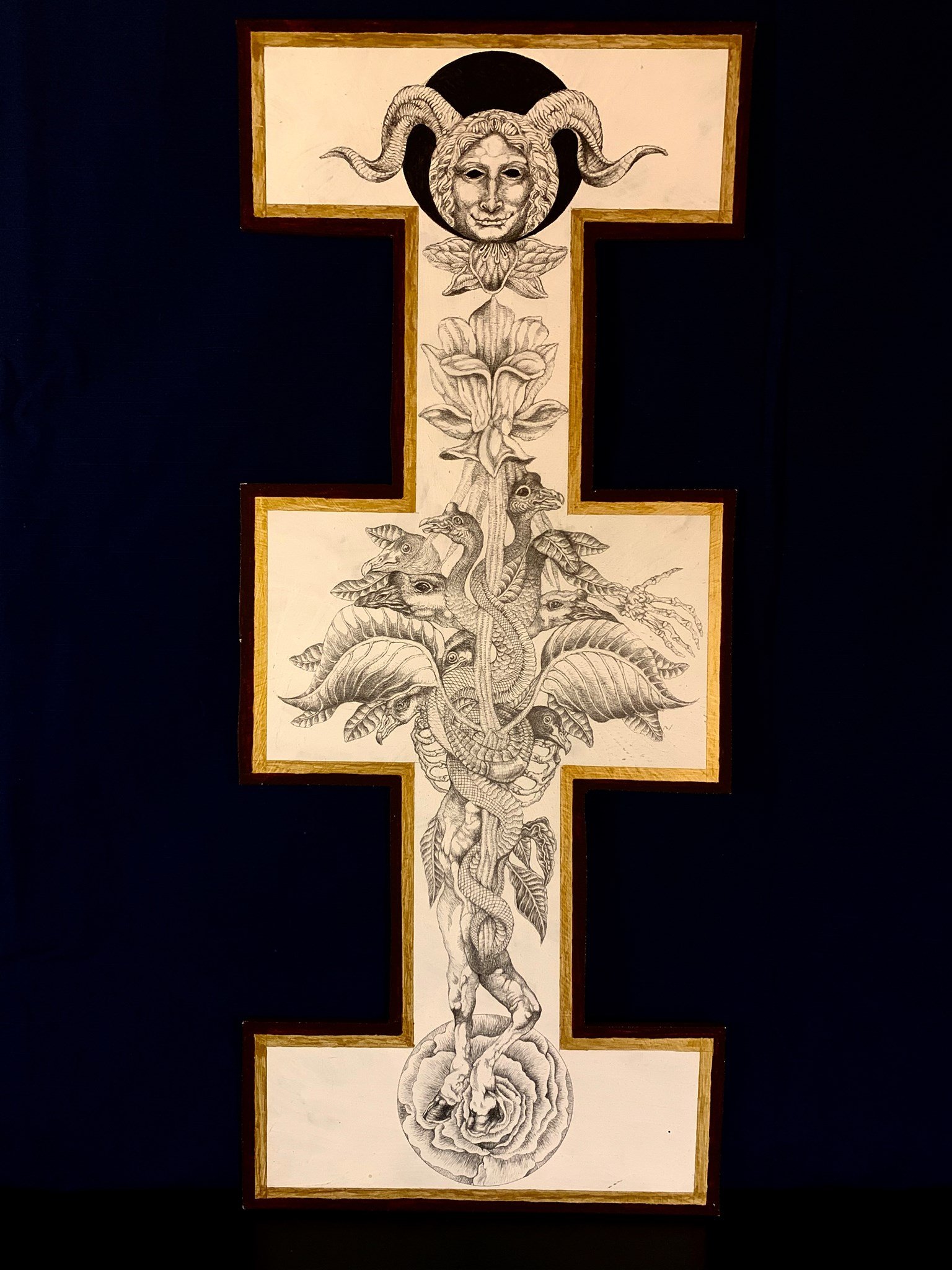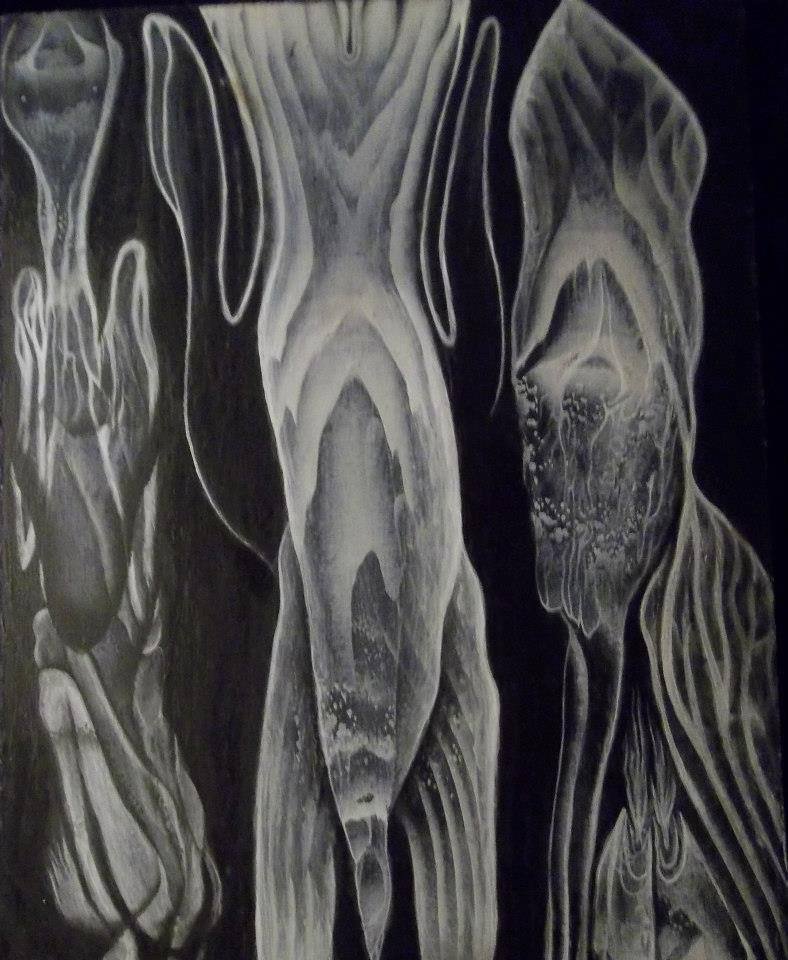This Series which I have titled “Black Hill Arcanum”, began with an alphabet of symbols I created based on what I could see as strong Sonoran Desert archetypes (of my daily surroundings) votive to the land and I used the skeleton of the “Fools Journey”, the 0-21 of the major arcanum to flesh them upon. So, in doing this rather than being arbitrary or too creative with my approach but also to keep a correspondence of a symbol system and meaning as well potentially thoughts on how I could use it. The results of this are the motivation behind the paintings (vessels) for this series. I have done this also from a dreamy thought of also wondering what the sensation would feel like to do this and explore this impulse. I had romanticized the thought within myself for a good while and with the time which the pandemic isolation days had given me I was able to go into it further. This also includes ideas provoked by folk art/ tales, and personal experiences (inner and outer/memory and experiences) to create a mythical body of these allegorical paintings with the glyph witting or based on exploring the archetypes themselves and what they express to me in this context. I wanted to combine these together in a more archaic folkish approach to art and also, I admit they are inspired by some Mesopotamian and Sumerian -what we would call art- which I get sucked into the vortex of, getting drawn into almost trance like reflective states just staring at them before going to sleep and what this stimulates in my creative imagination or possibly unconscious mind impressions.
Regarding the name “Black Hill Arcanum”, Tucson is my birthplace and where I grew up but moved away for a few decades before returning. While away though it was as if there was something missing in my life and when I moved back, I noticed many things I had forgotten came flooding back to me overwhelmingly and having a liminal sort of effect on me which I wanted to pay close attention to for many reasons. Being here now often feels like I am moving through ghost like membranes of space and time.
From what I have been able to find the word Tucson comes from the Tohono O'odham Tu-uk-so-on or Stjukson meaning "Black Base" or Cuk son and Stjucson (Shook-shon) meaning "At the base of the black hill". The Black Hill refers to a small mountain/hill in Tucson known as Sentinel Peak. It is called this because the base of this is darker than the summit due to the volcanic rock. Also at the base of this is the Santa Cruz riverbed which is where the indigenous people grew crops largely for making corn and mesquite flour. The "desert" people as they became to be labeled who were occupying this area are said to be the progenitors of the Hohokam (sources perhaps as early as 300AD) and are well known for their sophisticated knowledge and practice of irrigation canal development for agriculture. At the top of this hill is where sentinels would be stationed to watch for potential invaders, hence the name Sentinel Peak.
Also bringing up a previous blog post on my great great grandfather Quintus Monier (1853-1923) an example of what I see of how an ancestral experience has changed my thinking somewhat and continued to affect my perception in very interesting and meaningful ways. Another point to this I find significant is that when he moved here to Tucson he did not have building resources when commissioned to create the Saint Augustine Cathedral in Tucson. In order to remedy this problem he started a brickyard which produced bricks by mining clay from the Santa Cruz river floodplain, at the base of the black hill (Sentinel Peak). So this was a thing that I found to contribute significance in choosing the name "Black Hill Arcanum", and why I was instinctually choosing to use a building as my subject matter which turned out to be built by my great great grandfather.
-Another fun fact about this Cathedral is that it ranks within the 10 most haunted places in Tucson and is among them in a popular local ghost tour. Some of the more popular sightings include levitating faceless nun phenomenon as well as other sightings including the apparition of St. Catherine Drexel, the founder who died in 1955.
“In addition to the cathedral, Monier used bricks from his brickyard to build the El Paso and Southwestern Railroad Roundhouse (still standing in Tucson), St. Mary’s Sanatorium, the Santa Rita Hotel, several buildings on the University of Arizona Campus, and many residential homes.” (Desert Archaeology project director Mike Diehl)
Coming back to the title of “Black Hill Arcanum” and this is all why I have chosen it. I do feel an unfolding mystery exploring these impressions through the series and the more I dig into this the stranger and more meaningful it becomes to me on a personal level. There are many questions I would like to explore and many things I may never understand but already a good deal of inspiring things have come to me through this endeavor. So it is a presentable series as it is but also ongoing and being developed and I will continue to evolve new work in this gallery as it unravels through the process.
One last thing that I find interesting is that when I was growing up here there was a sort of local urban legend about an old witch who lived in the desert where we spent a lot of time which children are warned about and should always be terribly careful of crossing paths with. This created strong abstract memories in my childhood which lingered on and after moving back here I was determined to discover where this old myth came from, if it had a source. The only link I could sort of narrow this down to was from the famous local Tucson artist Ted Degrazia, my grandmother told us that he had done a piece of artwork including this character as his subject matter, this thing we saw as some kind of supernatural witch like entity. I went through his work until I eventually had found it. I learned that it was called the Ho'ok and the artwork which Degrazia had done was titled, “HO’OK Basket of Many Children”. This strange eldritch mythic character was at times confused with La Llorona and there are similarities with her looking for children out in the desert although for different reasons, but ultimately quite distinctly different all around in background. While looking for information into the history of this I read that the Baboquivari mountains southwest of Tucson, Arizona which some sources noted possess a sacred cave system below the peak that is represented by the labyrinth in the indigenous glyph design many Tucsonans may be familiar with seeing around known as the "Man in the Maze" symbol of this area where a creator God resides below. If I am understanding correctly what I have found, the Baboquivari mountains is sited cosmologically as a place where the human race was at one time taken deep into the earth (the underworld) saved before the proverbial floods occurred and then brought back thereafter to repopulate this desert land. Anyway, because this seemed for me to be a difficult thing to find and also somewhat relevant in the way it had perhaps been a source that ambiguously affected my early memories, I am including it here for anyone who would like to read a version of it (published in 1980 by University of Arizona Press).
I´itoi and Ho´ok ´oks
as told by
Ventura José
I´itoi is called Elder Brother (Si´ihe) by all the Papago people. He was the First Born, the first to come forth at the beginning of things, when the sky came down and met the earth:
Long ago, they say, when the earth was not yet finished, darkness lay upon the water, and they rubbed each other. The sound they made was like the sound at the edges of a pond. There, on the water, in the darkness, in the noise, and in a very strong wind, a child was born. (Saxon, Legends and Lore of the Papago and Pima Indians)
I´itoi prepared the earth for the Papago people, and then he went away to his home on Baboquivari Peak. The following story tells of how I´itoi saved the people from the Ho´ok ´oks. It was told to Susie Ignacio by her great-uncle Ventura Jose who lived in Vajillo, Sonora, Mexico, and first transcribed and translated by Professor William Kurath. Papago linguist Daniel Matson passed it on to Ofelia Zepeda who has done a new transcription for this publication. The translation is essentially Professor Kurath's.
There lived a youth, swift and handsome, who was all that parents want their children to be. Elder Brother became jealous of him. He decided that he would do something to this boy. So he went to where lived a bold woman and said to her: "Go very early tomorrow to get water at the foot of the mountain. A young man will come, and he will be kicking his kickball. From a distance he will approach kicking his kickball; it will roll toward you and pass beside you, and you will pick it up and hide it by sitting on it. He will ask you if you have not seen his kickball. You will tease him and tell him that you will give it to him if he will mix your powder with water and drink it. He will try to refuse but will not be able to get around it, and he will drink this mix that has an eagle feather ground up in it."
The next day before sun-up, the girl went with her olla on her head to sit there where the water was. Just as the sun was coming up the young man came running from a distance. When he had come to a certain point he kicked the ball, and it rolled right toward her and rolled past her. She took it and sat on it to hide it. He came there on the run but could not find it. "I kicked my ball and it rolled this way, didn't you see it?"
"You can't find it anywhere," the girl finally told him laughingly.
"You did see it, but you didn't tell me! Come on, give it to me!"
Then finally the girl said: "Will you make a potion of this flour so that I may give you your kickball?"
He didn't want to do it, but he finally gave in when she refused to give the ball to him.
So he drank her potion. After one big swallow, he shook all over. I suppose it went all over him, and he drank and drank until he had drunk it all up. He started growing feathers all over. The girl saw that he had turned into an eagle. After repeated shakings, he flew a short distance and sat down. Finally she got up and could not find the kick ball she had sat on, so the girl went to her home and told what had happened to the young boy.
Some months later this girl gave birth to a girl child. Right away, the people found out that there was going to be something queer about this child because she was so strong and grew so rapidly. Her mother did not know what to do. As soon as she was able to walk she would fight with other children. Sometimes, when she could, she would kill the child. Later on when she grew older she proceeded to fight with the big children. Whenever she would kill a child she would eat it raw. When the people looked on this child they were afraid because now she was eating big people too. The people had a conference trying to decide what to do with this weird being, Ho´ok as they called her.
They couldn't think what to do, so they said they would tell Elder Brother and maybe he would tell them what to do. So they sought out a fast runner who would run up to see Elder Brother up on Baboquivari Peak where he lived.
In a few days the wise man appeared and told them that they were to bring the girl to him and he would tell her something. They brought her. Elder Brother said to her: "You never knew who your father was. I will tell you right now." He showed the Ho´ok the desert land, and he said: "Do you see that thing before you?" And there was only a mirage out in space. The Ho´ok looked and believed the Si´ihe. Then and there he told her to go after her father to try to see her father. But she never caught up with him, because whenever she got near, the mirage would be farther in front of her again. She got further and further away, but she never reached it. When she came to what is now called Green Well she found out that she would never reach her father, and she wept. She climbed up on the mountain there and found this one cave in which she made her home.
She became very old. Every morning she would stand on top of the cliff and sniff in all directions. From whatever direction she would smell a baby she would run that way. When she got there from where the smell of the child came, she would say: "Grandchild, Grandchild! You will bring the child, I want to see it." Then they would give her the child; she would hold it for a little while in her arms, then suddenly she would claw on its stomach, and she would put it in her burden basket and away she would go carrying it on her back. The people told each other that she was their greatest fear. Almost from the very first the people found out and when they heard her from a far distance, they would hide their children. They would hear her - she would be making this noise as she ran because she wore fingernails, bones, and teeth on a necklace and some for a belt. From a far distance, when she was just on her way, they would hear her make this jingling and rattling noise. When the women heard this they would hide their offspring very securely. When she came, she would not go away, but there she would keep on sitting. Now and then a child would cry and right away she would ask them for it.
As time went on she ran out of very small children and started on the big children. She did not seize girl children but seized only the male children. The mothers told their young boys that when the Ho´ok went under a mesquite tree, they should hang onto a branch of it. The child would sit up in the tree until the Ho´ok got far off, and then he would run back home. When the children caught on to this, they would say right away to her, "I want under the tree, my grandmother."
She kept on doing this until later on she got to where, if she could, she would kill grown people. Also she knew all about things, about hunting, pottery making and basket making, and about whatever women knew or men knew. The people got together and discussed what they ought do to this old woman. Some said: "If we are not able to kill her, she will do away with us all by killing us.
There were some who said that they must tell Elder Brother and hear what he had to say. They looked for one who was a very fast runner who would run up to tell Elder Brother. The youth ran from there and was gone for a number of days. When he arrived up where Elder Brother was, by running, he saw a poor decrepit old man lying there. He told Elder Brother why they had sent him.
Elder Brother said: "Run back home, and perhaps I shall be there when you arrive." The young man thought to himself: "Where could you run to, old man?" Just as soon as he got back home he told them: "Your friend is lying down all exhausted. He didn't look as though he could do anything." Even as he was saying this, Elder Brother stood before them in the shape of a very young man. The Si´ihe was like that and could change himself to anybody.
It was told that if a person was to live a long time, he would see him as an old man, and one who would die soon would see him as a very young man. Then the people gathered together and heard that which he told them of his wisdom: "I have an idea, but it will be very hard work. Now you will have a big 'sing' here and a big dance and you will drink lots of sahuaro wine. You will sing for four days and nights. The Ho´ok ´oks will be on the go through all this time. During all this time some others will carry firewood to put at the mouth of the cave where the old woman lives. Still some others will make matted grass doors; they will place them at her home. During all this time the old lady will be on the go. You will make a cigarette with these ingredients, and you will pass it around, but you will remember that you must only pretend to smoke; the old lady will not know what it is, and she will smoke avidly, because she likes to smoke very much. After doing this she will want to go to sleep, but those of you who are standing next to her will not permit her to sleep. When she can't help it any longer she will sleep and fall down. Her house will be finished by this time and she will be carried and laid in it."
The people did what the Si´ihe told them to do. Four days and four nights they sang and during all this they danced. Some of them got ready and gathered a lot of firewood at her house. Some made doors, and they also placed them there. During all this the old woman was on the go. Every once in a while the dancers passed a cigarette around, and they gave it to her. She took big puffs and she inhaled very vigorously because she liked it so much. The people only pretended to smoke. She tried very hard to keep up with them but with all this she became tired and sleepy. Sometime later when she became very sleepy she tried to go home, but they wouldn't let her. She would stand in the dancing line, and she would dance again. When sleepiness overcame her, they held her up and made her dance.
The only thing she feared was rattlesnakes, and whenever she couldn't endure her drowsiness she would try to run home, and yet she had to cross an arroyo in which some people would be sitting; so when she passed, they would shake their rattles and she would turn right back and she would be dancing again. Three nights and three days they had been dancing, when she couldn't endure any longer, so she slept and they carried her and pushed her along.
Then the Si´ihe said: "It is time that you carry and place the old lady in the cave." A whole bunch helped each other and took her. Some carried her, and they put her in the farthest corner. They would put one of these doors, then from there they would place firewood, and then they would put another door. They did this until they reached the entrance of the cave with their doors and piles. Then they set fire to it all; it burned and burned for some time; then the old lady cried and said: "My grandchildren! Be kind to me and save me!" When the fire reached her she jumped up and down, and she cracked the top of the cave. The Si´ihe tried immediately to step on the crack, but a wisp of smoke had already escaped, and it became a blue hawk.
Right there the Ho´ok ´oks was done away with; but this hawk that was formed was bothering them far more than she had done. Because he didn't care whom he beat down and killed; and when he was flying high above, he would swoop down and beat down anyone that was walking along; then he would grab him or claw him, then fly away with him.
Once again, the people planned to kill this hawk. One at a time, certain individuals would tell their plan of how to kill this hawk. Then plans were worked out, but it didn't turn out the way they wanted it. They tried everything, but they couldn't find any way by which they could kill the hawk. So they again said they would ask the Si´ihe how they could kill the hawk which was killing them off.
The best pottery makers were asked to make four big ollas. Bigger than any that they had ever made. They would put these ollas in a row. They would put their openings towards the north, because it was from that direction that the hawk came down. So the very best potters did what they were told and made the big ollas. The Si´ihe had told them that they should find the prettiest girl and place her in front of these ollas. It wasn't long before the hawk was flying over them. They took out the ollas and put them in a row towards the north. The girl stood in front of them. After they had done this, all the people ran away in different directions. After the hawk flew around for a while, it swooped down and tried to beat down the girl but she was watching out for him so he passed right by her and fell into one of the very red hot ollas. Right then and there the life of the child which was formed from a kick ball was really ended.
But what became of the youth who became an eagle after drinking the girl's potion? Just as she saw the young man turn into an eagle, the girl ran home and told the people what had happened. All the people ran out to that place, but they couldn't do anything.
This eagle flew away until he found a crack which was in the highest part of the mountains, and there he made his home. From there he would fly repeatedly over the people and kill them. The hunters tried to shoot him down, but they couldn't kill him, because he was big and very strong. One day, he stole a girl and took her up to his cave.
Some time passed. They found out that this girl bore a child, but no one ever saw it because she would never come down. During all this time the eagle flew around over them and killed.
They again talked among themselves and discussed what they should do to this eagle. Again the Elder Brother saved them; he said: I will go myself and see if I can't kill this thing that you are afraid of. Some days will pass, and if from the east red clouds appear, you will know that the eagle has killed me; but if white clouds appear you will know that I have killed the eagle."
Then Elder Brother went, and when he reached the foot of the mountain he looked high up above and saw the cave in which this eagle lived, but it was hard to get to that cave. However Elder Brother knew about everything, and right away he knew what to do.
He planted a gourd seed at the foot of the cliff. And in a short time the gourd grew, and it began to grow and grow, and before many days it reached the eagle's cave. Right away Elder Brother climbed up on this plant, and he climbed and climbed; and he got there about the time when the eagle wasn't home. There sat the woman with her child. He told her why he came: "But I will say that we will try to kill your child also so that there will be no offspring from the eagle who is killing the people." The woman agreed with this, and she told him that when the eagle came he slept right after eating, while she combed his hair. The child slept at the same time. Then Elder Brother said: "When he sleeps I will cut off their heads, and they will die."
Suddenly he heard something that sounded like a strong wind coming. The woman said that it was the eagle coming. As far as the eye could see, there were the remains of human beings lying around in the corners of the cave. Some were already rotten, and some weren't spoiled yet, and some still showed signs of life. Elder Brother shook himself very strongly and became a blue fly. And he flew and got under the dead bodies. Just as soon as the eagle came in, he sniffed in every direction while his child cried right away: "Came, came!"
Immediately the eagle said: "Has anybody come? I smell human meat." His old lady tried to say that it was the bodies of the dead people that were lying around. The eagle said: "Why is the child saying what he said?"
The woman said: "It's only that he has learned to say that word. That's how a child is when he is learning to talk."
The eagle said: "But I smell a live body."
Then he ran around and lifted up every one of the dead bodies. When he came to the one at the very bottom, the fly flew out from underneath. He tried to kill it. High above, was a crack in the rock and the fly went into that.
The eagle really did eat and sleep afterwards, and his child went to sleep by his side. His wife combed his hair. Before long he went to sleep. Just as soon as Elder Brother knew that the eagle was asleep, he turned back into a person. Right away he chopped off the heads of the sleeping ones. The child died right away, but the eagle didn't die at once. He flew in every direction without his head, and his feathers flew whitely far away.
The people saw that, from the east, white clouds appeared, thin and flat. Then they knew that Elder Brother had won. The white clouds that came forth were just the eagle feathers that came out whitely when the eagle came thudding down.
Ventura José. "Ho´ok ´oks" printed by permission of Daniel Matson.
(As printed in Larry Evers, ed. The South Corner of Time. Tucson, Ariz.: The University of Arizona Press, ©1980, p. 110.)




















